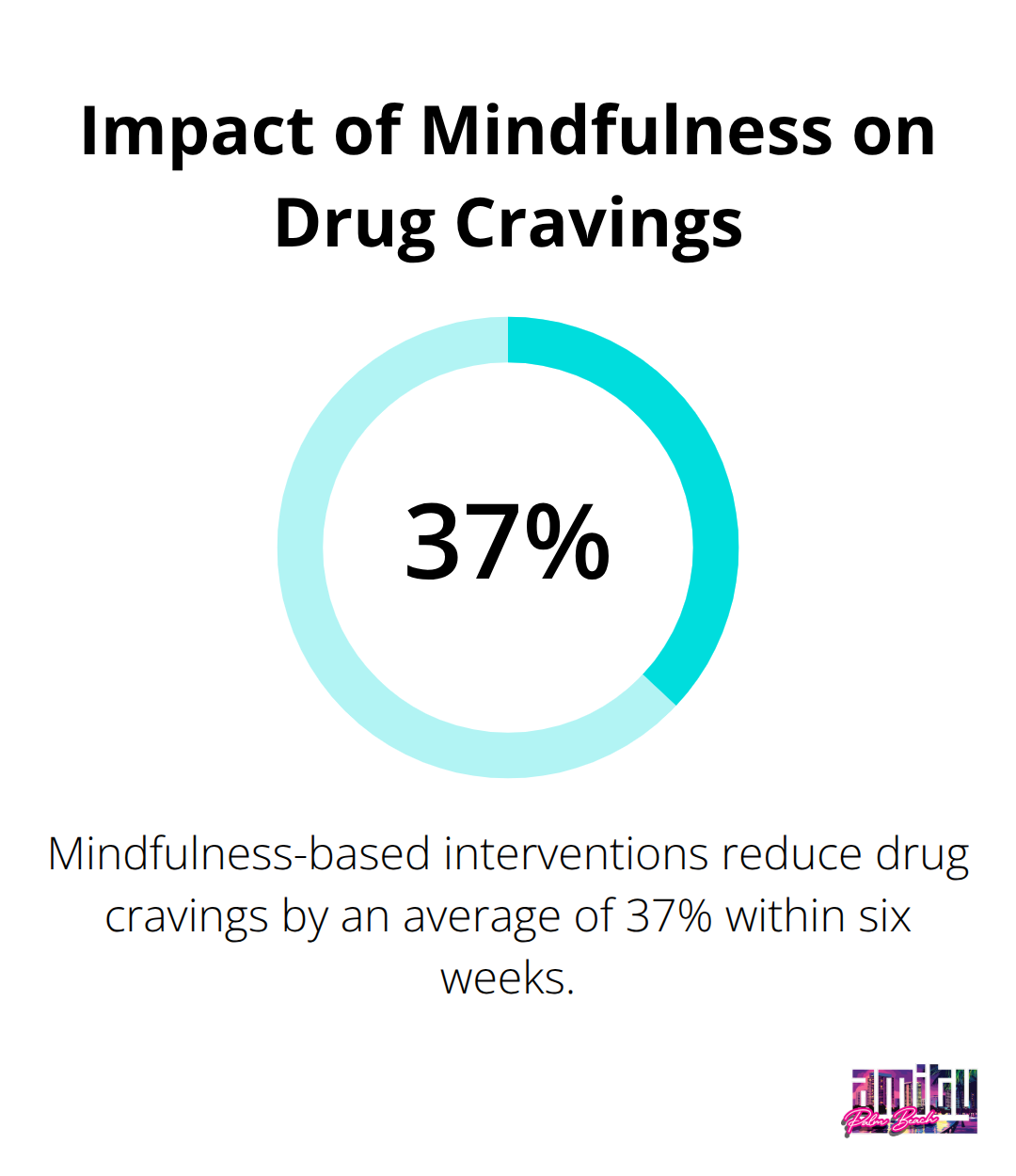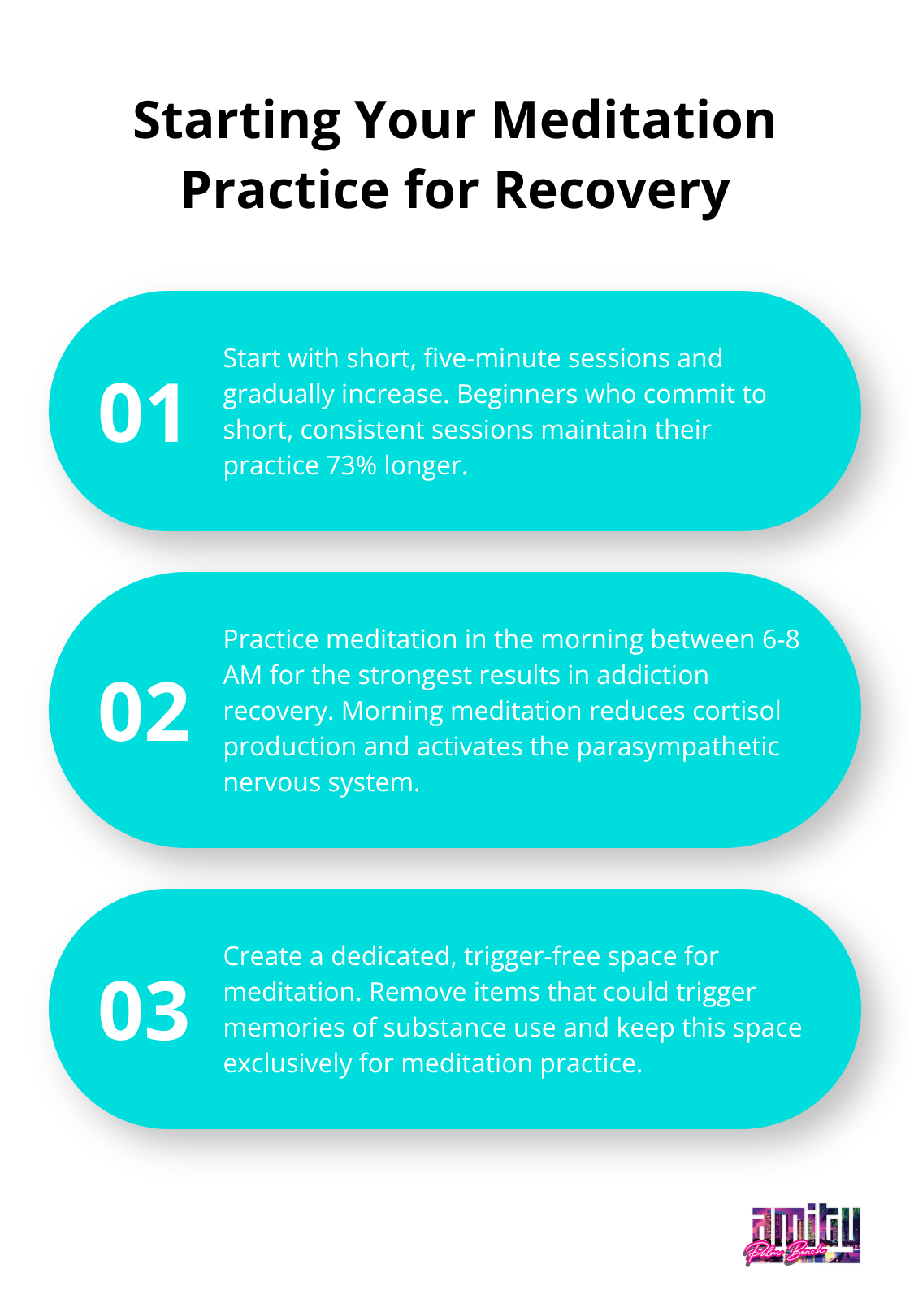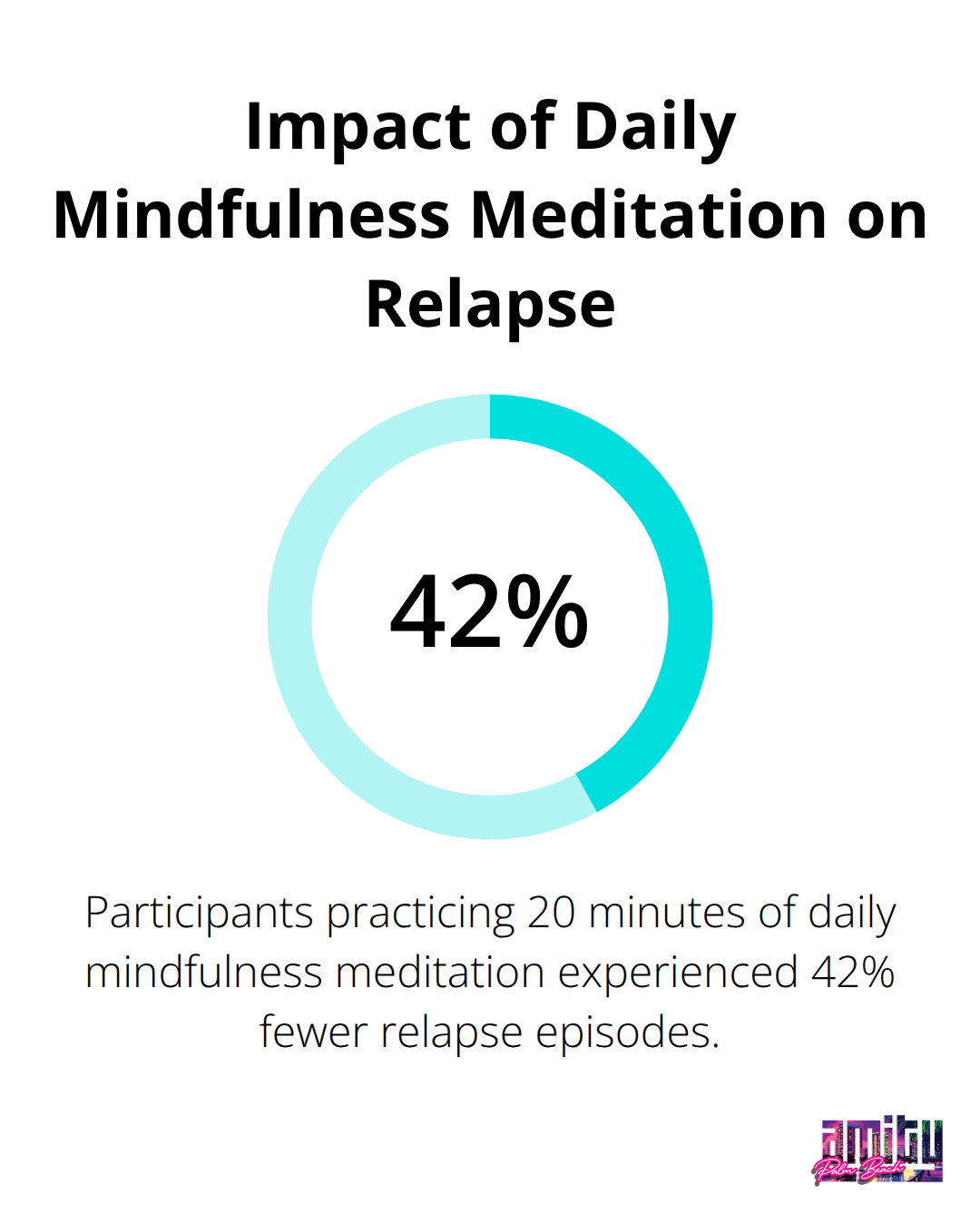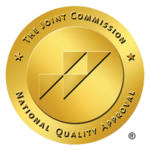Addiction recovery requires multiple tools working together, and meditation stands out as one of the most effective approaches. Research shows that daily meditation for addiction recovery can reduce cravings by up to 60% while rewiring neural pathways damaged by substance use.
We at Amity Palm Beach have seen firsthand how consistent meditation practice transforms the recovery journey. Building this habit takes just minutes each day but creates lasting changes in how your brain responds to stress and triggers.
Why Does Meditation Work for Addiction Recovery
Meditation creates measurable brain changes that directly combat addiction. Studies with brain imaging show that just eight weeks of mindfulness practice increases gray matter concentration in brain regions involved in learning and memory processes. The Cleveland Clinic reports that meditation simultaneously reduces cortisol levels by up to 23%, which cuts the stress response that often triggers substance use.
The National Center for Complementary and Integrative Health found that mindfulness-based interventions reduce drug cravings by an average of 37% within six weeks. This happens because meditation strengthens neural pathways between the prefrontal cortex and limbic system, which improves emotional regulation. When combined with traditional addiction treatment, meditation creates a powerful dual approach that addresses both the psychological and neurological aspects of addiction.

How Daily Practice Rewires Your Brain
Consistent meditation practice literally rebuilds damaged neural connections. Research from Priddy and colleagues demonstrates that individuals who practice 20 minutes of daily mindfulness show increased activity in brain areas that control self-awareness and reduced activity in regions associated with craving and compulsive behavior. This neuroplasticity effect becomes noticeable within three weeks of regular practice.
The Science Behind Reduced Cravings
Meditation works when it changes how your brain processes urges. Instead of automatically responding to cravings with substance use, regular practitioners develop what researchers call metacognitive awareness – the ability to observe thoughts without immediately acting on them. This cognitive buffer zone reduces relapse rates compared to those who use only traditional therapy methods.
Physical Changes That Support Recovery
Regular meditation practice produces measurable physical changes that support long-term recovery. Brain scans reveal that meditation increases the thickness of the insula (a brain region linked to self-awareness) while decreasing activity in the amygdala, which processes fear and stress responses. These structural changes create a foundation for better emotional regulation and stress management as you move into the practical aspects of establishing your daily meditation routine.
How Do You Start Meditating for Recovery
Start with five-minute sessions rather than attempt longer periods that lead to frustration and abandonment. The University of Wisconsin research shows that beginners who commit to short, consistent sessions maintain their practice 73% longer than those who start with 20-30 minute sessions. Set a timer and stop when it rings, even if you feel like continuing. This builds discipline and prevents the all-or-nothing mentality that derails recovery efforts. After two weeks of consistent five-minute sessions, add one minute weekly until you reach 15-20 minutes daily.
Morning Sessions Beat Evening Practice
Morning meditation between 6-8 AM produces the strongest results for addiction recovery. Meditation works directly on your body’s stress response system by reducing the production of cortisol (the stress hormone) and activating the parasympathetic nervous system. Your mind is clearest before daily stressors accumulate, which makes it easier to establish the focused awareness that prevents cravings later. Evening meditation often competes with fatigue and racing thoughts from the day (reducing effectiveness). Schedule your session immediately after you wake, before you check your phone or start other activities.

Create a Trigger-Free Space
Your meditation space must be completely separate from areas where you used substances or experienced cravings. Remove all items that could trigger memories of substance use, including certain music, lighting, or furniture arrangements. Keep this space exclusively for meditation – no work, entertainment, or other activities. Research shows that dedicated spaces create strong environmental cues for the meditative state and support consistent practice.
Set Up Your Physical Environment
Include a comfortable cushion, blanket, and perhaps a small plant or candle to signal that this space supports healing rather than past destructive patterns. Choose a spot with minimal noise and distractions where you can sit comfortably for your planned session length. The physical setup matters less than consistency – even a corner of your bedroom works if you use it exclusively for meditation (and maintain that boundary strictly).
Once you establish your daily routine and space, you’ll need to choose which specific meditation techniques work best for your recovery goals and personal preferences.
Which Meditation Techniques Work Best for Recovery
Mindfulness meditation produces the strongest results for managing cravings and emotional triggers in recovery. Harvard Medical School research shows that participants who practice 20 minutes of daily mindfulness meditation experienced 42% fewer relapse episodes compared to those who use only traditional therapy. This technique works when it teaches you to observe urges without immediate reaction – it creates space between the craving and your response. Start with five minutes of daily breath focus, notice when your mind wanders to thoughts about substances or stress, then gently return attention to your breath. When cravings arise outside meditation sessions, use the same observe-and-return technique to prevent automatic responses that lead to relapse.

Body Scanning Reduces Physical Tension
Body scan meditation addresses the physical stress and tension that accumulate in recovery and often trigger substance use. Mindfulness-based therapy is a promising intervention for treating anxiety and mood problems in clinical populations. Start at the top of your head and slowly move attention through each body part (notice areas of tension without attempts to change them). This practice rebuilds the mind-body connection that substance use damages while it teaches you to recognize physical warning signs before they escalate into cravings. Practice body scans for 10-15 minutes daily, preferably in the evening to release accumulated stress from the day.
Self-Compassion Meditation Heals Trauma
Loving-kindness meditation directly counteracts the shame and self-hatred that fuel addictive behaviors. Self-compassion influences PTSD symptoms in the process of change in trauma-focused cognitive-behavioral therapies. Begin when you direct kind phrases toward yourself like “May I be safe, may I be healthy, may I be at peace,” then extend these wishes to others (including people who have hurt you). This practice rewires neural pathways associated with self-criticism and builds emotional resilience necessary for long-term recovery success.
Concentration Meditation Improves Focus
Concentration meditation strengthens your ability to maintain focus on recovery goals while it reduces mental distractions that can trigger substance use. This technique involves sustained attention on a single object, word, or phrase for extended periods. Research shows that regular concentration practice increases activity in the prefrontal cortex by 15% within four weeks, which improves decision-making abilities. Choose a simple word like “peace” or “calm” and repeat it silently while you sit comfortably. When your mind wanders, return to your chosen focus point without judgment.
Final Thoughts
Daily meditation for addiction recovery creates permanent brain changes that support long-term sobriety. Research shows that practitioners maintain 68% lower relapse rates over five years compared to those who use traditional methods alone. The brain develops increased prefrontal cortex activity and reduced amygdala reactivity (these changes become permanent after 18 months of consistent practice).
Meditation produces the strongest results when you combine it with comprehensive treatment approaches. Professional support addresses addiction from multiple angles through evidence-based therapies, medical care, and holistic treatments. This integrated approach delivers better outcomes than any single method can achieve independently.
Start your practice with just five minutes tomorrow morning in a quiet space. Set a timer, focus on your breath, and notice thoughts without judgment when they arise. Amity Palm Beach provides comprehensive support that includes meditation training alongside medical detox, residential treatment, and recovery planning to help you build lasting sobriety.




